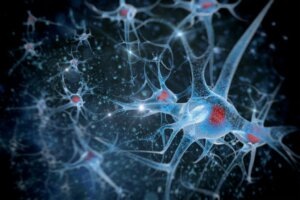The Importance of Neural Pruning


Written and verified by the psychologist Ebiezer López
Your nervous system is made up of millions of neurons connected via complex networks. In fact, from gestation, your body produces a huge number of neurons that fulfill various functions. However, not all the cells that are generated end up being useful. Therefore, they’re eliminated with neural pruning.
Neural pruning is a natural process that occurs at different stages of your life. It’s said to be essential for optimizing your brain activity and learning. However, some evidence indicates that it could also be related to certain well-studied mental disorders.
Neural pruning
Neurons are the anatomical and functional units of the nervous system. They’re both tiny and valuable. In fact, these cells form organs and tissues. Furthermore, they’re responsible for receiving and transmitting information through your neural networks. For example, when sound waves reach your ear, neurons stimulate nerve cells in that region. From there, a nerve impulse is sent to your brain that processes the information and interprets it as sound.
During gestation, when you’re an embryo, nerve cells begin to be produced in quantity. This process remains constant until you’re about two years of age. Consequently, a child has many more neurons than any adult. In fact, it’s said that the function of this overproduction is to facilitate children’s learning.
Everything you learn is fixed in your brain in the form of synaptic patterns. These are nothing more than connections that various groups of neurons create with each other. Hence, the more neurons available, the easier it is to link and build patterns.
However, not all neurons that are born become part of a network. These ‘leftover’ nerve cells are discarded with neural pruning. As the name implies, this process consists of removing non-functional neurons in order to optimize brain activity.

How does neural pruning work?
In childhood, around the age of two, a regulatory pruning process begins. It eliminates poorly functional connections. For example, the visual cortex of the brain discards a series of synapses with the spinal cord that promote the development of vision.
Then, in adolescence, another pruning process occurs. This remains active into adulthood. However, to date, the mechanisms that activate and regulate neural pruning in the nervous system aren’t entirely clear.
Fractalkine, complementary proteins, and microglial cells
In 2020, Sakai published an article in which she explains different hypotheses about neural pruning. One of them mentions fractalkine. This is a molecule that signals to the brain the need to activate microglial cells. They’re part of the body’s defenses and are responsible for swallowing pathogens to avoid diseases.
In an experiment with mice, the researchers disrupted the communication of the fractalkine between the neurons and the microglial cells. They noted that these mice had immature synaptic connections that wouldn’t otherwise exist.
As a rule, complementary proteins fulfill the function of signaling possible pathogenic cells in order to eliminate them. Thus, it’s suggested that these molecules, together with fractalkine, would mark circuits with low activity in order to destroy them.
The importance of neural pruning in a child’s development
The evidence accumulated to date indicates that the overproduction of neurons could be an evolutionary mechanism. Indeed, increased synaptic connections enhance learning in several ways. Because of this, it’s often said that children are like ‘sponges’, capable of learning very quickly.
However, too many connections can also slow down the journey of the nerve impulse. As a result, response times could be slower. In fact, this could be fatal if you’re in a dangerous situation. In addition, they demand more energy from the body and this isn’t useful for adaptation.
Therefore, neural pruning is carried out to remove synaptic pathways that aren’t frequently used. On the other hand, those that are activated are reinforced and optimized.
In this way, pruning favors learning that allows you to better adjust to your environment. Consequently, synaptic pruning is an essential mechanism for the development of your nervous system.

Synaptic pruning and its role in mental illness
There are reasons to believe that neural pruning could play a key role in the development of certain disorders. In this respect, Sellgren et al (2019) conducted a study on synaptic pruning in patients with schizophrenia. They concluded that excess synaptic pruning can precipitate or produce this disorder.
Similarly, other studies point to the possible role of synaptic pruning in the symptoms of Alzheimer’s disease. However, since we don’t understand how this mechanism works, it’s not possible to say for sure.
Finally, it’s suggested that neural pruning could be altered by various factors. For example, age and genetic defects. In fact, if these variables could be identified, it might be possible to regulate the symptoms of certain disorders that are associated with this mechanism.
Your nervous system is made up of millions of neurons connected via complex networks. In fact, from gestation, your body produces a huge number of neurons that fulfill various functions. However, not all the cells that are generated end up being useful. Therefore, they’re eliminated with neural pruning.
Neural pruning is a natural process that occurs at different stages of your life. It’s said to be essential for optimizing your brain activity and learning. However, some evidence indicates that it could also be related to certain well-studied mental disorders.
Neural pruning
Neurons are the anatomical and functional units of the nervous system. They’re both tiny and valuable. In fact, these cells form organs and tissues. Furthermore, they’re responsible for receiving and transmitting information through your neural networks. For example, when sound waves reach your ear, neurons stimulate nerve cells in that region. From there, a nerve impulse is sent to your brain that processes the information and interprets it as sound.
During gestation, when you’re an embryo, nerve cells begin to be produced in quantity. This process remains constant until you’re about two years of age. Consequently, a child has many more neurons than any adult. In fact, it’s said that the function of this overproduction is to facilitate children’s learning.
Everything you learn is fixed in your brain in the form of synaptic patterns. These are nothing more than connections that various groups of neurons create with each other. Hence, the more neurons available, the easier it is to link and build patterns.
However, not all neurons that are born become part of a network. These ‘leftover’ nerve cells are discarded with neural pruning. As the name implies, this process consists of removing non-functional neurons in order to optimize brain activity.

How does neural pruning work?
In childhood, around the age of two, a regulatory pruning process begins. It eliminates poorly functional connections. For example, the visual cortex of the brain discards a series of synapses with the spinal cord that promote the development of vision.
Then, in adolescence, another pruning process occurs. This remains active into adulthood. However, to date, the mechanisms that activate and regulate neural pruning in the nervous system aren’t entirely clear.
Fractalkine, complementary proteins, and microglial cells
In 2020, Sakai published an article in which she explains different hypotheses about neural pruning. One of them mentions fractalkine. This is a molecule that signals to the brain the need to activate microglial cells. They’re part of the body’s defenses and are responsible for swallowing pathogens to avoid diseases.
In an experiment with mice, the researchers disrupted the communication of the fractalkine between the neurons and the microglial cells. They noted that these mice had immature synaptic connections that wouldn’t otherwise exist.
As a rule, complementary proteins fulfill the function of signaling possible pathogenic cells in order to eliminate them. Thus, it’s suggested that these molecules, together with fractalkine, would mark circuits with low activity in order to destroy them.
The importance of neural pruning in a child’s development
The evidence accumulated to date indicates that the overproduction of neurons could be an evolutionary mechanism. Indeed, increased synaptic connections enhance learning in several ways. Because of this, it’s often said that children are like ‘sponges’, capable of learning very quickly.
However, too many connections can also slow down the journey of the nerve impulse. As a result, response times could be slower. In fact, this could be fatal if you’re in a dangerous situation. In addition, they demand more energy from the body and this isn’t useful for adaptation.
Therefore, neural pruning is carried out to remove synaptic pathways that aren’t frequently used. On the other hand, those that are activated are reinforced and optimized.
In this way, pruning favors learning that allows you to better adjust to your environment. Consequently, synaptic pruning is an essential mechanism for the development of your nervous system.

Synaptic pruning and its role in mental illness
There are reasons to believe that neural pruning could play a key role in the development of certain disorders. In this respect, Sellgren et al (2019) conducted a study on synaptic pruning in patients with schizophrenia. They concluded that excess synaptic pruning can precipitate or produce this disorder.
Similarly, other studies point to the possible role of synaptic pruning in the symptoms of Alzheimer’s disease. However, since we don’t understand how this mechanism works, it’s not possible to say for sure.
Finally, it’s suggested that neural pruning could be altered by various factors. For example, age and genetic defects. In fact, if these variables could be identified, it might be possible to regulate the symptoms of certain disorders that are associated with this mechanism.
All cited sources were thoroughly reviewed by our team to ensure their quality, reliability, currency, and validity. The bibliography of this article was considered reliable and of academic or scientific accuracy.
- Sakai, J. (2020). Core Concept: How synaptic pruning shapes neural wiring during development and, possibly, in disease. Proceedings of the National Academy of Sciences, 117(28), 16096-16099.
- Sellgren, C. M., Gracias, J., Watmuff, B., Biag, J. D., Thanos, J. M., Whittredge, P. B., … & Perlis, R. H. (2019). Increased synapse elimination by microglia in schizophrenia patient-derived models of synaptic pruning. Nature neuroscience, 22(3), 374-385.
- Sootha, B. (2021). Deleting Neurons: A closer look at Synaptic Pruning. ScienceOpen Posters.
This text is provided for informational purposes only and does not replace consultation with a professional. If in doubt, consult your specialist.







